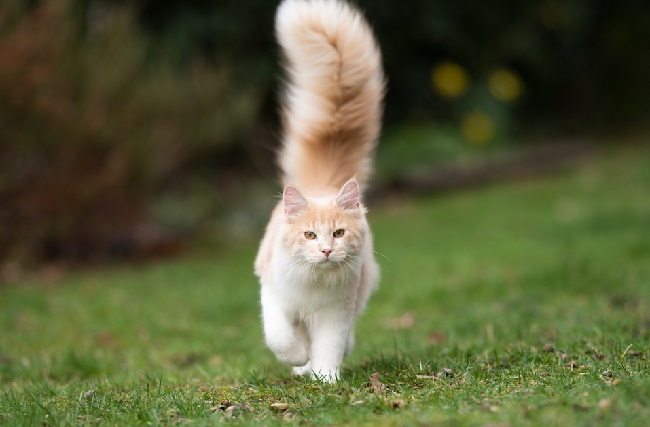Cats communicate volumes through their tails. From the bushy puff of fur to the gentle swish, each movement carries meaning.
This guide explores various cat breeds known for puffing their tails, decodes tail swishing, and explains what it means when your feline friend displays these behaviors.
Cats are enigmatic creatures, often showing affection and contentment in subtle and diverse ways. Understanding where they like to be petted, interpreting the meaning behind a puffed tail, and recognizing signs of affection can deepen the bond between cats and their owners.

Breeds of Cats Known for Puffing Their Tails
Certain cat breeds are notorious for having expressive tail behaviors, including the puffing of their tails. Breeds such as the Maine Coon, Norwegian Forest Cat, and the fluffy Persian often exhibit a puffed tail as part of their body language repertoire.
What Does a Cat’s Tail Swishing Mean?
A cat’s tail swishing can indicate a variety of emotions. It can be a sign of irritation or concentration, especially if swishing while focused on prey. Understanding the context is key to interpreting this behavior.
The Meaning Behind a Cat’s Tail Held High
When a cat holds its tail high in the air, it’s usually a sign of confidence and contentment. This posture can signify that a cat is feeling friendly and approachable.
Why Cats Arch Their Back and Puff Their Tail
A cat that arches her back and puffs her tail is typically in a defensive stance. This behavior is designed to make the cat appear larger and more threatening to potential predators or aggressors.
Reasons Behind a Cat Fluffing Her Tail
A fluffed tail can also be a reaction to excitement or surprise. If your cat fluffs her tail during play or when startled, it’s a normal part of their instinctive behavior.
Understanding Why Your Cat’s Tail Puffs Up When They See You
If your cat’s tail puffs up upon seeing you, it could be a sign of excitement or mixed emotions. It’s crucial to observe their other body language cues to accurately gauge their feelings.
Decoding Why Your Cat Huff and Puff
If your cat huffs and puffs, it could be expressing annoyance or stress. However, if accompanied by labored breathing, a vet check-up is advisable to rule out any medical issues.
Where Do Cats Like to Be Pet?
Cats generally enjoy being stroked on their head, chin, and along their back. These areas are where their scent glands are located, and petting them here can help them feel relaxed and secure.
Do Cats Puff Their Tails When Happy?
A cat puffing its tail can be a sign of excitement or agitation. While not typically associated with happiness, it can occur during playful moments when the cat is happily stimulated.
How Do Cats Show Affection?
Cats show affection through purring, gentle headbutts, kneading, and slow blinking. Each cat may have a unique way of expressing love, often tailored to their human companion’s responses.
Why Do Cats Raise Their Tail When You Pet Them?
When a cat raises its tail while being petted, it’s usually a sign of trust and enjoyment. A high, quivering tail can indicate particular excitement and a friendly greeting.
Do Cats Like Tummy Rubs?
While some cats may enjoy tummy rubs, many do not. The stomach is a vulnerable area, and touching it can trigger a defensive reaction. It’s important to read your cat’s body language.
How to Tell if a Cat Loves You?
Signs that a cat loves you can include following you around, bringing you “gifts,” sleeping on or near you, and showing a desire to play and interact with you regularly.
Feeding Your Cat and Puffing Tail Behavior
A cat’s tail may puff during feeding time if they are overly excited or feel threatened. Ensuring a calm, secure feeding environment can minimize this behavior.
Bathing a Cat with a Puffing Tail
Bathing can be stressful for cats, often causing a puffed tail. Understanding your cat’s tolerance and using calming techniques can help make bath time less stressful.
Understanding Sleeping Time and Tail Puffing in Cats
Cats typically sleep for 12-16 hours a day. If a cat puffs its tail while sleeping or waking, it could be a response to a dream or external stimulus.
Conclusion
Cats use their tails to communicate a complex array of emotions. By paying attention to these signals, cat owners can better understand and respond to their pet’s needs and moods, ensuring a happy and healthy cat.
To truly understand and care for your cat, it’s important to pay attention to their body language and individual preferences. By doing so, you can create a nurturing environment that caters to their needs and fosters a loving relationship.
